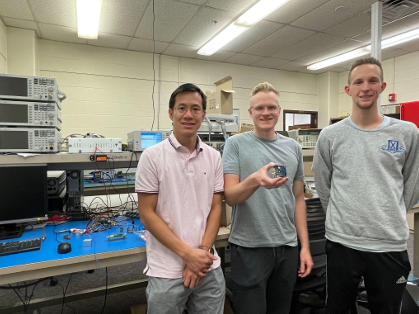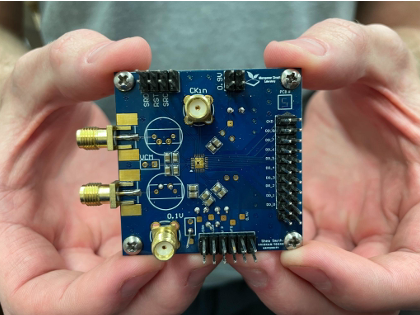
Graduate student Shea Smith worked with Dr. Chiang and fellow graduate student Taylor Barton to create an analog-to-digital converter with the lowest supply voltage ever reported.
The device Smith created is called an analog-to-digital converter (ADC), which takes real-world signals such as touch, temperature, or pressure, and then digitizes the signals into a format that computers can use to process, store, and interpret. Essentially, the device allows signals to be digitized into binary code, which can be later accessed or analyzed for various purposes. ADCs are often used in sensory-based systems, such as systems that measure data or communication systems.
Previously, the lowest supply voltage reported by anyone was 150 millivolts, but Dr. Chiang and Smith’s research cut the voltage down to 120 millivolts, a significant achievement given the exponential dependency of the circuit on the supply voltage at such low levels. At the same time, they managed to improve the performance by a factor of 600 from the state-of-the-art -- a remarkable feat. A lower supply voltage is beneficial because a lower supply voltage can eliminate the need for a battery. Instead, it opens up the possibility of using solar panels or an RF harvester, which do not need to be changed out or maintained at the same rate as batteries. The ADC consumes a measly 72 nano-Watt, about 200 million times less than the power of an LED light bulb. The circuit is suitable for internet-of-things or implantable biomedical devices that need to operate autonomously for long periods of time.
This project was the culmination of four years of graduate research sponsored by NASA and yielded a research paper entitled A 0.12-V 200-Hz-BW 10-Bit ADC Using Quad-Channel VCO and Interpolation Linearization published in the prestigious IEEE Asian Solid-State Circuits Conference (A-SSCC) sponsored by the IEEE Solid-State Circuits Society. We are very proud to see BYU faculty and students succeed and contribute in meaningful ways to the engineering community, and look forward to seeing what they accomplish in the future.

